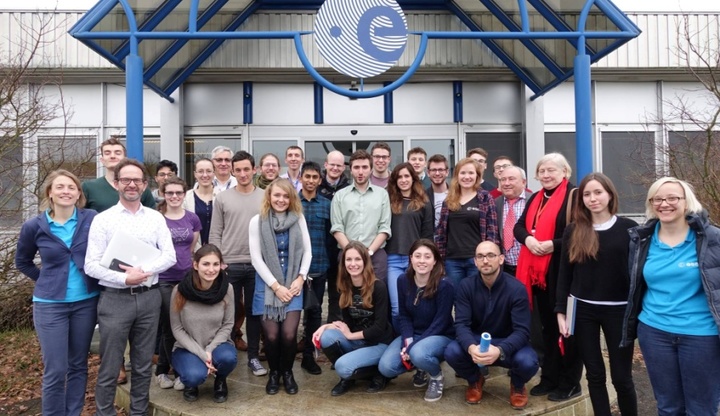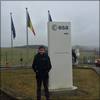KnO₂weldge 9 leads a student on a fantastic journey to ESA
When student Alfred Hill came along to CASE Medicine's KnO₂wledge 9 conference in November 2016, he was expecting a day filled with interesting talks and networking with other fellow space medicine fans. Little did he know that a simple conference booklet would spark a furious race to complete an application that would see him attending a course run by the European Space Agency.
In his own words, Alfred tells us about this amazing opportunity and what it taught him. Please also visit the gallery for some photos of his trip
They say that opportunities never walk into your life and announce themselves, but at the KnO₂wledge 9 conference in last November exactly that happened to me.
By Alfred Hill
On the final page of the programme was a description of a short course on human space physiology being run by the European Space Agency (ESA). With the deadline only a week away, it was a scramble to pull together the required paperwork but with hours to go my application was submitted. The course was open to anyone studying a relevant field from Europe, so I wasn’t holding out much hope; however, in early December I received notice that I was expected in Poix Saint Hubert on January 29th 2017.
After a long day of travel, a few of the other UK participants and I arrived at our destination, and the rest of the group arrived from across Europe over the course of dinner. The majority were medical students, with a few studying biological masters and a solitary aerospace engineer! With an early start looming and a highly anticipated week ahead of us, it was an early night for all.
The next morning, we boarded our coach and were greeted by Dr David Green one of the course organisers. As we travelled towards Redu village he told us about the format for the upcoming week, and after a short journey we were treated to our first sight of the distinctive satellite dishes of ESA Redu Centre that were to become very familiar.
Having been ushered into ESA Academy’s new state-of-the-art Training and Learning Centre, we met those who would be joining us via conference call from the European Astronaut Centre in Cologne. The speakers would be split between the two sites, and a video link established to allow questions from either end. After that, we were placed into teams of four and given our group project which we would be presenting at the end of the course. I found myself working on “Female Flyers - How to support female astronaut health” a convenient assignment given I am currently on my Women’s Health rotation!
The remainder of Monday’s lectures were very much an introduction to space as a field. We heard from Dr Reinhold Ewald about his own experiences on the Russian station MIR, including the constant monitoring via 42 attached sensors and how his hatred for broccoli developed. Dr Raimund Lenten gave us a whirlwind tour of the history of human spaceflight, from the development of the rocket equation all the way through to the Shuttle programme and the future of the ISS. A short break for lunch and then we were discussing the boundaries of space, and the challenges it’s environment poses with Dr David Green.
The first day ended with a special visit to the nearby Euro Space Centre for an exclusive evening tour. We toured life size replicas of both the Shuttle and the Columbus module currently installed on the ISS, and saw demonstrations of how advances in technology meant for space have been applied on Earth. We were also fortunate enough to get to try out a few of the simulators they have, including a multi-axis trainer and a “moon walk” (a clever blend of VR and a spring-powered harness!). All in all, an excellent start.
The second day started to focus in on the biological aspects of microgravity. Our first lecture was from Dr Jack J.W.A. van Loon on animal/cell studies and how they are used to predict the effect that space may have on us. Dr Green then followed on with a description of how we scale these models up for use on human volunteers; as well as the isolation experiments that have been carried out across the globe to examine the psychological impact of confinement on an Explorer class mission.
Day three saw us begin to talk about individual physiological system, Dr Floris Wuyts lectured on the vestibular system, as well as the evidence for microgravity induced neuroplasticity. His extraordinary data set of astronauts and volunteers on a parabolic flight made for some fascinating MRI images.
In between his lectures, we diverged into the mechanical, with a talk on the technical considerations of maintaining conditions suitable for human life on a long-term mission. The afternoon was spent discussing the cardiovascular and musculoskeletal systems, the astronaut’s exercise regime was scrutinised to determine the ways it helped combat orthostatic hypotension, yet failed to ameliorate excessive bone resorption.
The final day began with the largest and most underappreciated organ, the skin. Dr Betty Nusgens went into great detail about her research into fibroblastic reactions to microgravity, down to a molecular level! The following talk covered how to protect the skin, Dr Juergen Wenzel discussed the past, present and future of barosuits. The prospect of decompression sickness and application of Technical scuba diving principles to space travel were particularly unusual. Our final two lectures were on the medical challenges of deep space, and a second one on terrestrial analogues. The former was a rapid discussion of Explorer missions and the particular difficulties they would face, and the latter was an overview of the many projects currently undertaken by the ESA; with special focus given to the Antarctic base postings.
Our weird and wonderful week of space physiology concluded with a series of 15 minute presentations prepared by the students. Most had been worked on in evenings and the early hours of the morning, and they covered a breadth of topics ranging from how to feed astronauts to the prospects of the first extra-terrestrial birth.
I had a fantastic time on this course, the lectures were informative and expertly delivered; the organisation was superb (even getting us some time in the robotics classroom!) and my fellow students were great fun. I can only hope that ESA decides to run this course again, and if so I would recommend it to anyone with even a passing interest in what will happen to our bodies when we walk amongst the stars".
Share this :


 ESA Space Physiology Course
ESA Space Physiology Course


